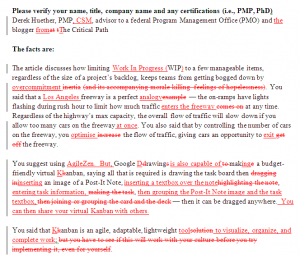When the Agile Manifesto for Agile Software Development was written 10 years ago, it stated "We are uncovering better ways of developing software by doing it and helping others do it." The very first of four values listed within the Manifesto was "Individuals and interactions over processes and tools"
The Manifesto goes on to state "...while there is value in the items on the right, we value the items on the left more."
Well, I am compelled to write about one of the items on the right. I still believe the tool should be good enough that it helps you reach your goals. But after that, it should not become a big process onto itself. What I want to do is finish tasks and get some actual closure on them.
I recently read in the book Personal Kanban by Jim Benson and Tonianne DeMaria Barry, a phenomenon known as the "Zeigarnik Effect". It states that 90% of people remember uncompleted or interrupted tasks better than completed tasks. Soviet psychologist Bluma Zeigarnic found that the human brain becomes preoccupied with things that are not closed.
Though I have leveraged Kanban with teams, it took me a while to realize that Visual Control Systems could be used to visualize and manage both personal and professional work. I then found myself using a physical board at the office and an electronic version (web-based tool) at home.
What is visual control, exactly?
A visual control is a technique employed in many places where information is communicated by using visual signals instead of texts or other written instructions. The design is deliberate in allowing quick recognition of the information being communicated, in order to increase efficiency and clarity.
The real question is, can a process tool take the place of individuals and interactions? Perhaps we need to stop and think about the reality of our world. Is everyone in your company physically located in the same office space or are you geographically dispersed? If you're not all sitting there together in an open workspace, you need to find a tool that will bridge that physical gap and then stay out of the way. Bandit Software's LeanKit Kanban does that. Let me tell you what puts LeanKit in the lead of the Kanban tool race. It's called mobile computing.
I seem to carry my iPad with me everywhere. (I'll be getting an iPhone as soon as my contract is up). Though the LeanKit iPhone/iPod interface could use a little work, the iPad interface is completely awesome. The image above is actually a screen print from my iPad. The design is simple; it's lightweight; it's functional. It helps me visualize my work and it helps control my work in process. Merge LeanKit Kanban and an iPad and you will have an amazing user experience, as it allows individuals to interact wherever they see fit. I'm happy because I can access half a dozen different boards with tap of my finger and my wife is happy because I didn't cover the walls of my home office with whiteboards and sticky notes.
If you're thinking about using a web-based Kanban tool for yourself, your team, or your organization, all of the vendors out there have relatively similar features. See which one fits your budget. If you or your teams are using mobile devices like iPhones, iPods, or iPads (in addition to desktops or laptops), you need to go to iTunes and download this app. Though you need to have an existing LeanKit account to make the Apple App versions work, you can get a personal account for free!
After you see how well it works for your personal life, I don't doubt you'll be using it in the office in the not-too-distant future.
HT: Wikipedia HT: LeanKit HT: Personal Kanban





 , it made me stop and question why people wanted to get the PMP or APP. Are we trying to discover better ways to deliver value to customers or just trying to get a piece of paper and a few extra letters after our names? Dan breaks it down to pursuing the mastery of performance-based objectives versus learning-based objectives (ie. getting a passing score on a certification exam versus learning new approaches to deliver value to customers).
, it made me stop and question why people wanted to get the PMP or APP. Are we trying to discover better ways to deliver value to customers or just trying to get a piece of paper and a few extra letters after our names? Dan breaks it down to pursuing the mastery of performance-based objectives versus learning-based objectives (ie. getting a passing score on a certification exam versus learning new approaches to deliver value to customers).


 by Eliyahu M. Goldratt (yes, if someone clicks on that link and buys a book, I would get credit)
by Eliyahu M. Goldratt (yes, if someone clicks on that link and buys a book, I would get credit)